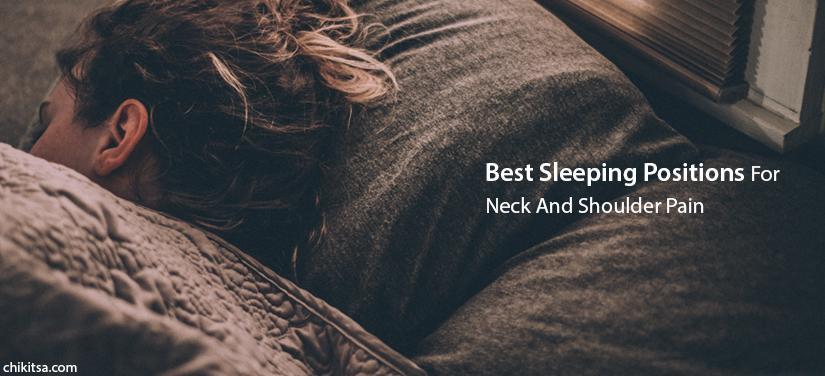Best Sleeping Positions For Neck And Shoulder Pain

Our body is complex machinery of integrated units (different body parts) which work in tandem to produce the appropriate body movements. However, there are situations when such body parts do not function accordingly and the system goes wrong. Not only does the body functioning goes wrong, at times such wrong dis-coordinated moves can even be quite painful. The human neck and shoulder region is a complex area which houses various critical yet crucial anatomical structures.
However, this crucial area of the human body is also very sensitive and prone to various risks such as the risk of injury, pain, restricted movement, and degenerative conditions. While various causes of neck and shoulder pain, especially those related to wear and tear of tissues around the area or other factors, are not under human control, there are certainly various tactics and strategies which can avoid the risk of pain or at least aggravating such pain around the neck and shoulder region.
One of the primary critical factors related to neck and shoulder pain is the way we sleep and our sleeping postures. Being aware of the best sleeping positions for avoiding the risk of neck and shoulder pain would be the wisest piece of information.
Best Sleeping Positions For Neck And Shoulder Pain
While every individual has his or her own comfortable sleeping postures (there are studies which tend to judge an individual’s characteristics based on his/her sleeping positions and postures), the two most comfortable sleeping positions for one’s neck and shoulder include
- Sleeping on one of our sides
- Sleeping on our back
Sleeping on our back is the preferred and clinically proven best sleeping position for people suffering from chronic neck pain since in this position our spine tends to stay neutral. In fact, doctors prescribe the ideal sleeping position depending on the kind of pain such as
Back Pain
In the case of back pain, the ideal sleeping position would be sleeping on the back and maintaining the natural curve of the spine by placing pillows under the knees. In case, the individual still prefers sleeping by his/her side or stomach, necessary precaution needs to be taken in order to keep the spine erect. In case of back pain, however, the scissor sleeping position, in case of sleeping on the side with one leg lying over the other should be avoided.
Neck Pain
In case of neck pain, one should try sleeping on the back or by his/her side that too with adequate cushions as mentioned below. However, sleeping on the stomach should be absolutely avoided in case of neck pain since such a posture creates maximum stress for the neck region.
Shoulder Pain
In case of shoulder pain, one should sleep by the side (choose the opposite side (compared to the shoulder which has pain) such that the shoulder with pain left free). Such a side sleeping posture should be supported well with a pillow. In case, the individual wishes to sleep on the back, adequate cushioning needs to be done for the injured shoulder. Sleeping on the stomach should be absolutely avoided since such a posture leaves the shoulders unstable causing more pain.
It is important to understand that in order to avoid neck pain, it is important to choose the right kind of sleeping pillow. Apart from this, there are certain do’s and don’ts which need to follow in order to avoid neck and shoulder pains. Some of such do’s and don’ts include
- Sleeping on our stomach can actually be painful and stressful for our spine as the back (spinal cord) tends to get arched while the neck is usually turned towards one side. Hence, this particular sleeping position is not recommended.
- Choosing a rounded pillow while sleeping on our back in order to support the natural curve of our neck. Such a round pillow should be complemented with a flatter pillow which should be used for cushioning our head.
In order to do so, one can choose a
- Special pillow with built-in neck support and an indentation for the head to rest in
- Tucking a small neck roll into the pillowcase of our flatter and softer pillow to serve the purpose
- Try using a feather pillow which can easily conform to the shape of our neck. However, feather pillows usually tend to collapse over time and thus needs replacement almost every year or so.
- Using a traditionally shaped pillow with"memory foam" which conforms to the contour of our head and neck. Usually, such a pillow is good for a sore neck, especially if special cervical pillows made with memory foam are used to relieve such pain.
- Avoiding the use of too high or too stiff pillows as these can keep our neck flexed for the entire night which can thus result in pain and stiffness in the morning.
- Trying to keep our spine straight by using a pillow which is higher under our neck as compared to our head, in case we prefer sleeping on one of our sides.
- Using a horseshoe-shaped pillow which can support our neck and prevent our head from dropping to a side while we doze off when traveling on a car, train, or plane.
While following the above-mentioned tips in order to maintain a perfect body posture while sleeping, itis important to understand that not only the sleeping posture but even our sleep can affect the neck and shoulder region. Thus symptoms such as difficulty in falling asleep or trouble staying asleep for long, waking up quite early in the mornings, and usually non-restorative sleep patterns can also lead to musculoskeletal pain around the shoulder and neck region.
The preferred sleeping positions mentioned above help us stay fit, healthy, and away from painful episodes. However, such sleeping positions usually get set during the early stages of our life and these can often be hard to change later in our lives. Another hard fact related to our sleeping patterns is that we often do not get up in the same posture we slept in. But at the same time, it is advisable to try using the best sleeping positions for neck and shoulder pain while sleeping at night with due support around the back and neck region in order to avoid a painful start of our next day.








